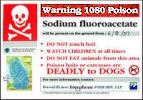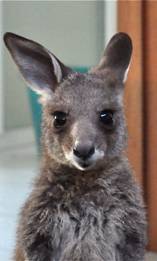1080 Poison – A toxic chemical- that our native animals do not deserve
 Human exposure to 1080 is very severely restricted by law, for obvious reasons. The same does not apply to other species in baited areas. The major animal welfare concern over the use of 1080 relates to its extreme cruelty and its lack of an antidote. The major environmental concern relates to its effects on non target animals, either through ingestion of baits or by secondary poisoning.
Human exposure to 1080 is very severely restricted by law, for obvious reasons. The same does not apply to other species in baited areas. The major animal welfare concern over the use of 1080 relates to its extreme cruelty and its lack of an antidote. The major environmental concern relates to its effects on non target animals, either through ingestion of baits or by secondary poisoning.
Article by Sheila Newman with Maryland Wilson, President, Australian Wildlife Protection Council (AWPC)
1080, sodium fluoracetate, is all bad news
1080, sodium fluoracetate- for which there is no antidote, is cheap and easy to use, but a cruel solution.
 (Photo of Eastern Grey joey, "Acacia," by Brett Clifton.The late Dr Peter Rawlinson La Trobe University zoologist stated in 1987 (as an Australian Conservation Foundation Councillor):
(Photo of Eastern Grey joey, "Acacia," by Brett Clifton.The late Dr Peter Rawlinson La Trobe University zoologist stated in 1987 (as an Australian Conservation Foundation Councillor):
“The wallaby does not know the carrots will poison and kill her...they are laced with 1080; she will die and her joey will starve! There is no antidote to the progressively slow and agonising death...as her functions fail...” Photo: Brett Clifton “When ingested, wallabies, possums, wedge-tailed eagles that feed on smaller prey are progressively debilitated and die a slow, agonizing death as its systems fail. Death may ultimately result from a variety of causes ranging from heart failure to suffocation. There is no antidote to 1080 poisoning”.
For these reasons, human exposure to 1080 is very severely restricted by law. The same does not apply to other species in baited areas. The major animal welfare concern over the use of 1080 relates to its extreme cruelty and its lack of an antidote. The major environmental concern relates to its effects on non target animals, either through ingestion of baits or by secondary poisoning... the toxic chemical that slowly kills.
Secondary poisoning
Secondary poisoning occurs when animals, such as birds of prey, eat poisoned mammals. Falcons and eagles are a case in point. Many of these animals are increasingly rare:
"Australia and its territories host 35 species of birds of prey: 24 diurnal raptors and 11 owls, many of which are endemic. Nine species and as many subspecies are listed as threatened nationally and/or regionally....
As predators at the top of food chains they are vulnerable to secondary poisoning and the accumulation of persistent pesticides, and subject to persecution." Source: http://www.birdlife.org.au/documents/OTHPUB-Raptors.pdf
Pets and domestic animals victims of 1080
Dogs and even horses are at serious risk. Here is a case in New Zealand:
"The land treated could easily have been treated for possum control by safer alternative methods, ie. trapping and ferratox in bait stations, as it is NOT REMOTE, NOT INNACCESSIBLE, and NOT RUGGED TERRAIN.
It is obvious from the position of the animal, the damage to its leg, the vomited lungs and the distended veins, that this animal died a horrible and cruel death. Deer have been observed to have tried to rip open their own bellies in their agony, and have inflicted similar and worse damage to their bodies while under the effects of 1080. Dogs are driven insane by the excruciating pain inflicted upon them before succombing to a cruel death. Poisoned possums can travel several kms and may take up to 18 hours to die." Source: http://emigratetonewzealand.wordpress.com/2008/09/05/1080-3/
Dingos are a better idea than 1080
The alternative idea of supporting the return of terrestrial predators adapted to Australian conditions has recently been the subject of serious discussion, most recently and fascinatingly in this article by scientists, Corey Bradshaw and Euan Ritchie: "Can Australia afford the dingo fence?" The authors write:
"...Why do we invest billions of dollars in feral animal control and the subsequent recovery plans for endangered wildlife using the same techniques for decades, when a more proactive and natural alternative exists? It’s a solution mired in controversy because it involves yet another “introduced” predator – the dingo.
...And poisoning is not the answer either. In addition to killing non-target native species, baiting dingoes might in fact result in increased dingo densities due to social breakdown of the pack, resulting in increasing attacks on stock, not to mention a higher likelihood of hybridisation with feral dogs. Baiting also leads to more juvenile dingoes."
Article by Sheila Newman with Maryland Wilson, President, Australian Wildlife Protection Council (AWPC)

Recent comments